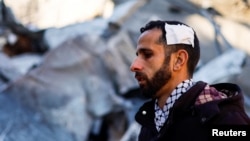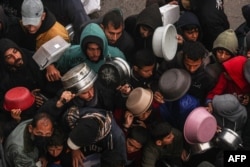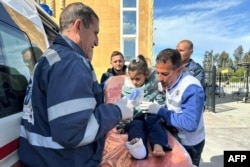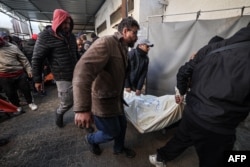The overcrowded Gaza border town of Rafah was the site of deadly strikes early Saturday. It was not immediately clear how many people were killed or wounded.
Meanwhile, the Hamas-run Gaza health ministry reported Saturday that at least 27,131 people have been killed and 66,287 have been wounded in Gaza since the October 7 attack on Israel by Hamas.
The United Arab Emirates has set aside $5 million for UNRWA, the United Nations Palestinian refugee agency. Some countries have suspended their contributions to the agency after news emerged that 12 of UNRWA’s employees participated in the October 7 attack.
Fighting continued Friday in the Gaza Strip, with health officials in the territory reporting that 105 people were killed overnight, according to Agence France-Presse. The news service quoted the Hamas press office as saying Israeli air and artillery strikes targeted the southern Gaza city of Khan Younis.
Reuters reported Friday that Israeli forces shelled the outskirts of Rafah in southern Gaza, where hundreds of thousands of Palestinians have fled since Israel began its assault on Khan Younis, one of its biggest offensives since the war began.
Speaking at a news briefing in Geneva Friday, spokesperson for the U.N. Office for the Coordination of Humanitarian Affairs, Jens Laerke, expressed his deep concern about the escalation of hostilities in Khan Younis and the subsequent increased number of people fleeing to Rafah.
Laerke told reporters that in recent days thousands of Palestinians have continued to flee south to Rafah, which is already hosting over half Gaza's population of some 2.3 million people.
“Most are living in makeshift structures, tents or out in the open,” Laerke told reporters Friday. “Rafah is a pressure cooker of despair, and we fear for what comes next."
Laerke said that among the U.N. agencies and their health partners, the greatest fear is disease. He said there is not enough food, clean drinking water or shelter.
At the same news briefing Friday, World Health Organization representative for occupied Palestinian areas, Rik Peeperkorn, said there are, at the minimum, 8,000 critically injured or sick people in Gaza who need to be sent to Egypt or elsewhere for medical treatment.
Potential cease-fire
Also on Friday, Hamas leaders indicated they have received and will respond soon to a proposal for a cease-fire agreement negotiated by Egyptian, Qatari and U.S. mediators in Paris earlier this week and approved by Israel.
AFP reported the proposal includes a three-stage plan, which would start with an initial six-week halt to the fighting and bring more aid deliveries to Gaza.
Qatari Prime Minister Mohammed al-Thani made a brief visit to the United Nations on Friday to meet with Secretary-General Antonio Guterres, a day after meetings in Washington with U.S. Secretary of State Antony Blinken.
"This is part of the secretary-general's ongoing consultations with the Qatari leadership,” U.N. spokesperson Stephane Dujarric told reporters. “The prime minister was here. They, no surprise, discussed the efforts underway to end the fighting, to secure the release of the hostages and to ensure support for humanitarian operations."
U.S. Ambassador to the United Nations Linda Thomas-Greenfield told reporters Friday that the deal under negotiation is a “strong, compelling proposal,” and she urged the U.N. Security Council to increase pressure on Hamas to accept it.
She warned that a draft resolution circulated in the council by Algeria on Wednesday, which referenced the International Court of Justice’s recent decision to impose provisional measures on Israel to protect Palestinians in Gaza, would not be constructive and could jeopardize the sensitive negotiations.
“We don’t see that this [draft] resolution adds anything to what we already have, but we worry that the resolution will hurt what we are doing on the ground right now,” Thomas-Greenfield said.
The Algerian text calls for an immediate humanitarian cease-fire, the protection of civilians and unhindered aid access. It also rejects the forced displacement of the Palestinian civilian population in Gaza. No vote is imminent.
U.S. opinion shifts
Also Friday, a poll conducted by The Associated Press-NORC Center for Public Affairs Research indicated 50% of U.S. adults think Israel’s campaign against Hamas in Gaza has “gone too far.” That is up from 40% in a similar poll taken in November, shortly after the war started.
Some information for this report was provided by The Associated Press, Reuters and Agence France-Presse.












